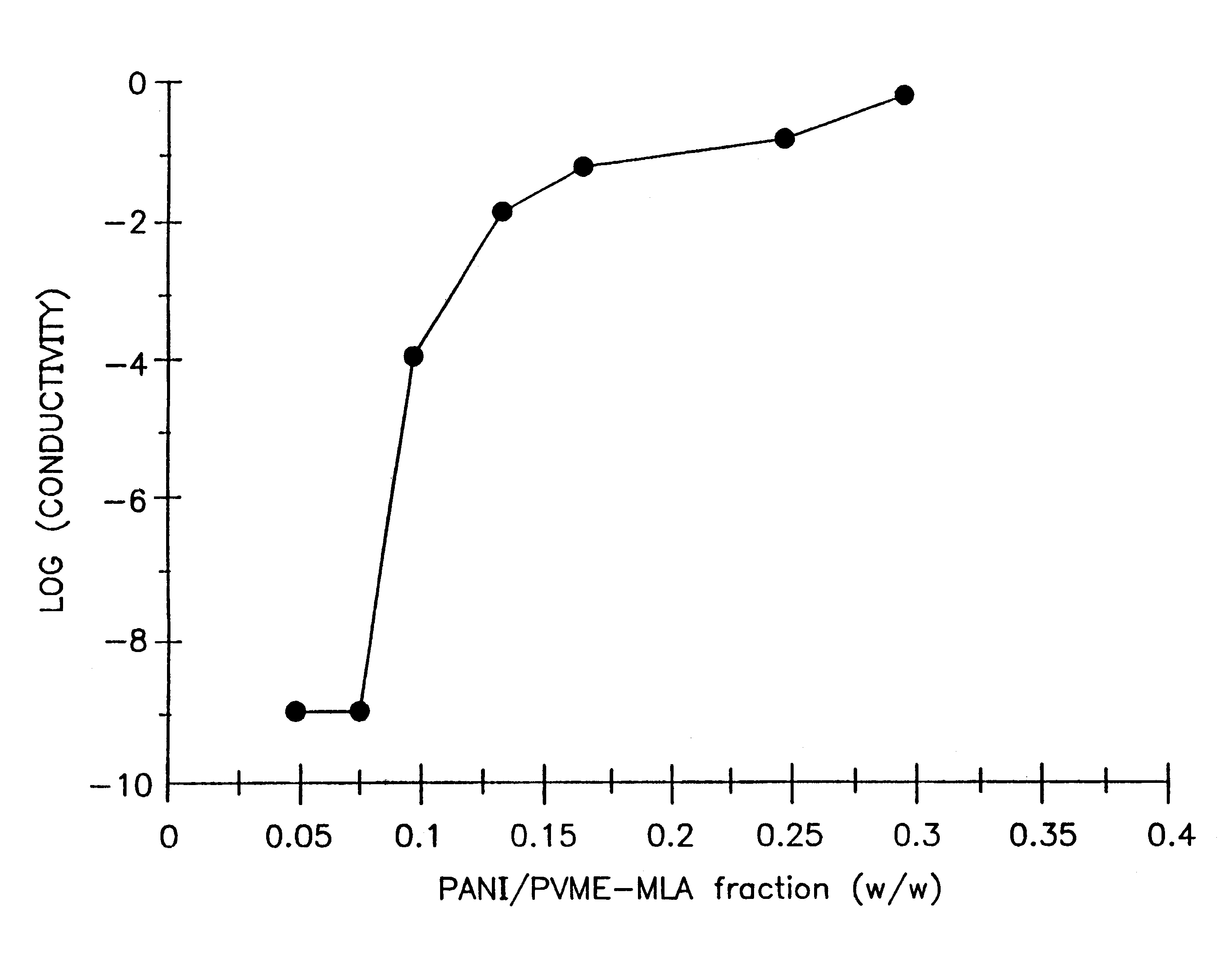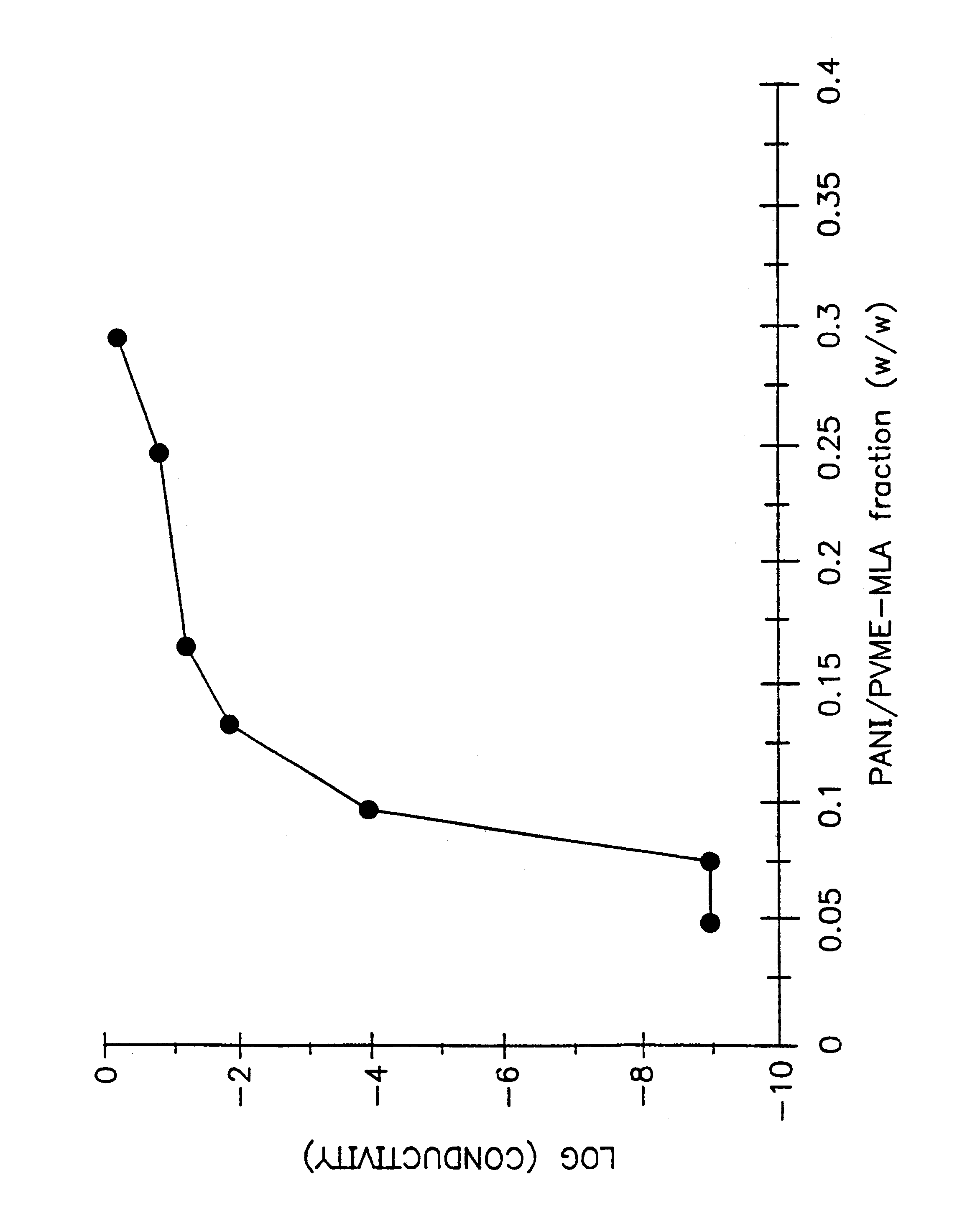Conducting polymers for coatings and antielectrostatic applications
a technology of conducting polymers and coatings, applied in the direction of conductors, non-metal conductors, organic conductors, etc., can solve the problems of low conductivity, difficult dyeing of electronic conductors, material stiffness, etc., and achieve high electrical (not ionic) conductivity
- Summary
- Abstract
- Description
- Claims
- Application Information
AI Technical Summary
Benefits of technology
Problems solved by technology
Method used
Image
Examples
example 2
Synthesis of Polyaniline: poly(acrylic acid) complex with r=N.sub.AN / N.sub.--COOH =1.5, [Polyaniline:poly(acrylic acid), r=1.5].
In this example, the aniline content is increased to r>1 to obtain stable suspension (or emulsion) in water.
Step 1: Adsorption of aniline onto poly(acrylic acid) to prepare [poly(acrylic acid):(Aniline).sub.n ]:
7.208 gm of 25% by weight of poly(acrylic acid) (from Polyciense, MW=90,000) was added to 10 ml of methanol, then water was added to make 100 ml of poly(acrylic acid) solution. This solution was transferred to a round bottom flask with a magnetic stirrer and continuous rigorous stirring was initiated for 15 min. (Total # of moles of carboxylic acid functional groups=0.025 mole).
3.492 gm of freshly distilled aniline was slowly added to the poly(acrylic acid) solution under rigorous stirring. An additional 10 ml of methanol was added. Stirring was continued for an additional 30 minutes. All solid materials were dissolved at this time. (Total amount of...
example 3
Synthesis of [PAN:PVME-MA, r=1]
1.92 gm of poly(vinylmethylether-co-maleic acid)m, PVME-MA, (containing 0.022 moles of carboxylic functional groups, Aldrich, M.W.=67,000) was dissolved in 25 ml of distilled water. 5 ml of methanol was added and slowly 2 gram of aniline (0.022 mole of aniline) was added to this solution and stirred for one hour. At this stage, aniline was adsorbed on PVME-MA to form the adduct [poly(vinylethylether-co-maleic acid):(An).sub.n.
25 ml 3 M HCl and 6.0.times.10.sup.-4 mole of ferric chloride was slowly added to the solution and stirred for 30 minutes. At this stage, the micro emulsion of the adduct [poly(vinlymethylether-co-maleic acid):(An).sub.n ] was stabilized to an appropriate size in the acidic solution.
2.5 ml of 3% hydrogen peroxide (containing 0.022 mole H2O2) was added slowly to initiate the polymerization of the adduct of aniline and PVME-MA. The reaction mixture soon become green in color. After vigorous stirring for 2 hours, the reaction mixture...
example 4
PANI:P(VME-MA), r=2
Synthesis of PANI / PVME-MA(--COOH / An=1:2)
0.96 gm of poly(vinylmethylether-co-maleic acid) (containing 0.011 mole of carboxylic functional group Aldrich, M.W.=67,000) was dissolved in 25 ml of distilled water. Then 0.022 mole aniline monomer was added. A white emulsion was formed. 5 ml of methanol was added to make a clear solution and the solution was stirred for 1 hour. 25 ml 3M HCl and 6.0.times.10.sup.-4 mole ferric chloride were introduced and then 0.022 mole hydrogen peroxide was slowly added into the reaction mixture. The reaction mixture soon become green colored. After vigorous stirring for 2 hours, the reaction mixture was poured through a filter paper to remove small amount of particles. The filtrate was a dark green homogeneous aqueous solution.
The suspension stability: the as-obtained solution remained homogeneous for over one year. The suspension remains stable when mixed with 0.37M Na.sub.2 SO.sub.4.
The conductivity measurement
The product solution was...
PUM
| Property | Measurement | Unit |
|---|---|---|
| Fraction | aaaaa | aaaaa |
| Electrical conductivity | aaaaa | aaaaa |
| Electrical conductor | aaaaa | aaaaa |
Abstract
Description
Claims
Application Information
 Login to View More
Login to View More - R&D
- Intellectual Property
- Life Sciences
- Materials
- Tech Scout
- Unparalleled Data Quality
- Higher Quality Content
- 60% Fewer Hallucinations
Browse by: Latest US Patents, China's latest patents, Technical Efficacy Thesaurus, Application Domain, Technology Topic, Popular Technical Reports.
© 2025 PatSnap. All rights reserved.Legal|Privacy policy|Modern Slavery Act Transparency Statement|Sitemap|About US| Contact US: help@patsnap.com



